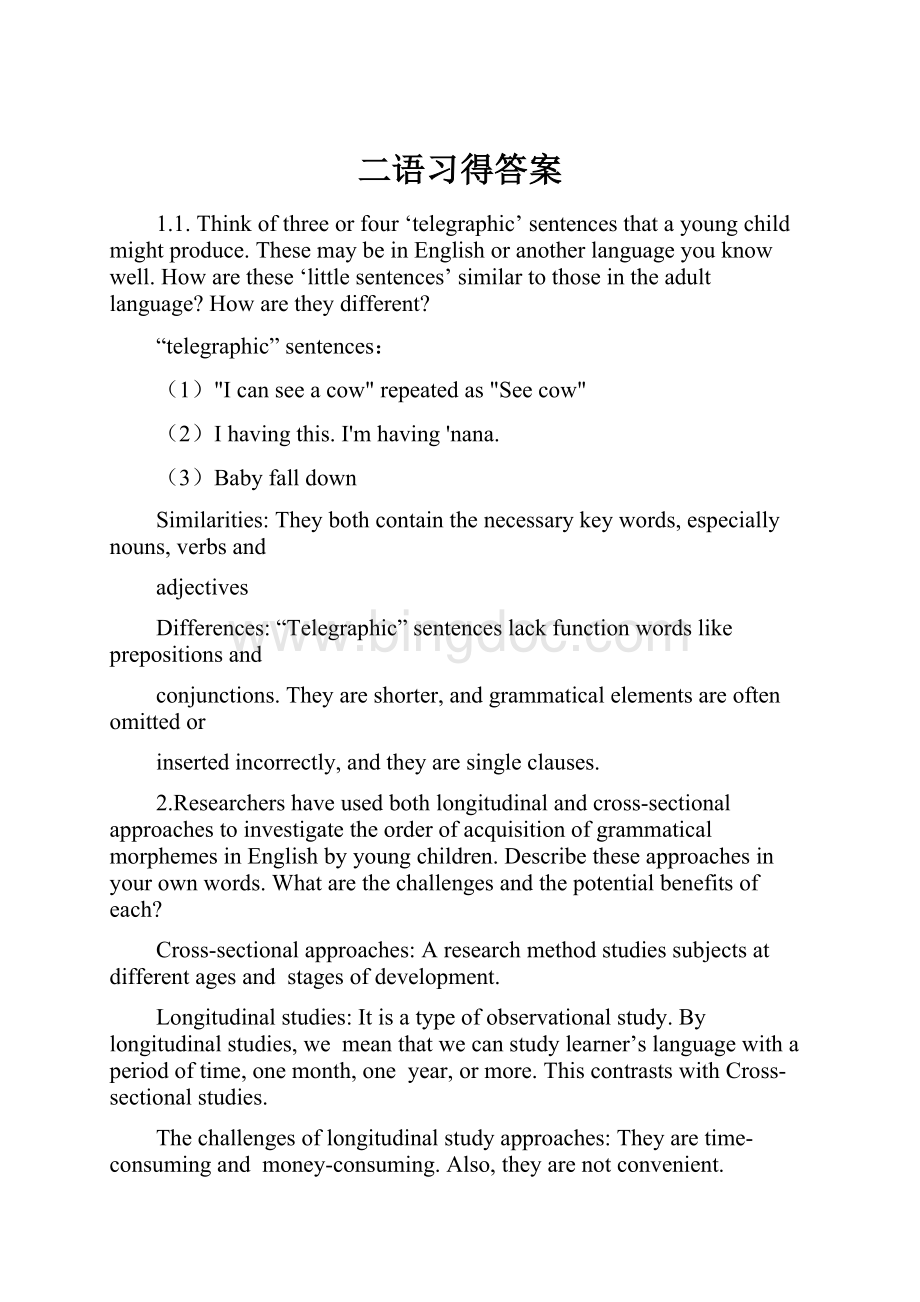二语习得答案Word文件下载.docx
《二语习得答案Word文件下载.docx》由会员分享,可在线阅读,更多相关《二语习得答案Word文件下载.docx(37页珍藏版)》请在冰点文库上搜索。

nana.
(3)Babyfalldown
Similarities:
Theybothcontainthenecessarykeywords,especiallynouns,verbsand
adjectives
Differences:
“Telegraphic”sentenceslackfunctionwordslikeprepositionsand
conjunctions.Theyareshorter,andgrammaticalelementsareoftenomittedor
insertedincorrectly,andtheyaresingleclauses.
2.Researchershaveusedbothlongitudinalandcross-sectionalapproachestoinvestigatetheorderofacquisitionofgrammaticalmorphemesinEnglishbyyoungchildren.Describetheseapproachesinyourownwords.Whatarethechallengesandthepotentialbenefitsofeach?
Cross-sectionalapproaches:
Aresearchmethodstudiessubjectsatdifferentagesandstagesofdevelopment.
Longitudinalstudies:
Itisatypeofobservationalstudy.Bylongitudinalstudies,wemeanthatwecanstudylearner’slanguagewithaperiodoftime,onemonth,oneyear,ormore.ThiscontrastswithCross-sectionalstudies.
Thechallengesoflongitudinalstudyapproaches:
Theyaretime-consumingandmoney-consuming.Also,theyarenotconvenient.
Potentialbenefitsoflongitudinalstudyapproaches:
Longitudinalstudiestrackthesamepeople,andthereforethedifferencesobservedinthosepeoplearelesslikelytobetheresultofculturaldifferencesacrossgenerations.
ThechallengesofCross-sectionalapproaches:
Routinedataarenotdesignedtoanswerthespecificquestion.
PotentialbenefitsofCross-sectionalapproaches:
.Theuseofroutinelycollecteddataallowslargecross-sectionalstudiestobemadeatlittleornoexpense.
3.Whatisthe‘wugtest’?
Whatdothefindingsfromthewugtesttellusabout
Children’sdevelopinglanguage?
Whatadvantagesdoesthewugtesthaveoverstudiesthatobservechildren’slanguageinnaturalsettings?
Canyouthinkofsomedisadvantages?
(1)“Wugtest”isaproceduretoexplorechildren’sknowledgeoflanguagedevelopedbyJeanBerkoGleason.ItwasdesignedasawaytoinvestigatetheacquisitionofthepluralandotherinflectionalmorphemesinEnglish-speakingchildren.
(2)Bytheageofthree-and-a-halforfouryears,mostchildrencanaskquestions,givecommands,reportrealevents,andcreatestoriesaboutimaginaryones-completewithcorrectgrammaticalmorphemes.
(3)AdvantagesofwugtestBycompletingthesesentences,childrendemonstratethattheyactuallyknowtherulesinEnglish,notjustalistofmemorizedwordpairs,andcanapplytheserulestowordswhichtheyhaveneverheardbefore.
(4)Somedisadvantages:
Theacquisitionofthemorecomplexgrammaticalstructuresofthelanguagerequiresadifferentsortofexplanation
4.Whatismetalinguisticawareness?
Whyisitaprerequisiteforbeingabletounderstandmostjokesandriddles?
Thinkofajokeorriddleyouknow.Howismetalinguisticawarenessrelatedtoyourunderstandingofwhatmakesthisjokefunny?
(1)Metalinguisticawarenessistheabilitytotreatlanguageasanobject,separatefromthemeaningitconveys.
(2)BecauseMetalinguisticawarenessincludesthediscoveryofsuchthingsasambiguity---wordsandsentencesthathavemultiplemeaning.
(3)Jokes:
Whyisthebridefeelingunhappyinherwedding?
Becauseshecannotmarrythe‘bestman’.
5.Whathaveresearchersobservedaboutthefrequencywithwhichyoungchildrenengageinimitationandrepetitivepractice?
Inwhatwayareyoungchildren’slinguisticimitationandpracticepatternsdifferentfromthoseofsomeforeignlanguageclasses?
(1)Observation:
●Firstyear,mostbabiescanunderstandquiteafewfrequentlyrepeatedwords.
●Speechconsistsofimitation,butdifferentchildrenhavedifferentrateofimitation
●Children’simitationsarenotrandom;
theydonotimitateeverythingtheyhear
●Childrensometimesrepeatthemselvesorproduceaseriesofrelatedpracticesentences
(2)Differences:
Linguisticimitationandpracticepatternsarethenaturalprocessinwhichchildrensubconsciouslypossessanddevelopthelinguisticknowledgeofthesettingtheylivein.Youngchildrenlearnlanguagethroughexposuretothelanguageandmeaningfulcommunication.
Foreignlanguageclassestakeplacewherethetargetlanguageisnotthelanguagespokeninthelanguagecommunity.Childrenhavetheneedofsystematicstudiesofanykind.
6.Giveexamplesofbothgrammaticalandlexicalovergeneralizationerrorsfoundinearlychildlanguage.Whatisthegenerallearningprinciplethatunderliessucherrors?
Examplesofgrammaticalovergeneralizationerrors:
Randall(2,9),whoisinstage3ofquestionformation,concludedthatthetrickofaskingquestionsistoputacertainword(inthiscase:
are)atthebeginningofthesentence.forexample:
Aredogswiggletheirtails?
Correctform:
Dodogswiggletheirtails?
Examplesoflexicalovergeneralizationerrors:
Michel(2,0)says:
Mummy,I'
mhiccingupandIcan'
tstop.
(Michelhasheardmanytwo-wordverbswithup,suchas"
standingup"
and"
pickingup."
Sohemakessuchageneralization.)
Thegenerallearningprinciplethatunderliessucherrors:
(1)Childrenappeartopickoutpatternsandthengeneralizethemtonewcontexts.Theycreatenewformsornewusesofwordsuntiltheyfinallyfigureouthowtheformsareusedbyadults.Theirnewsentencesareusuallycomprehensibleandoftencorrect.
(2)Behaviorisminfirstlanguagelearning.
7.HowdothestoriesofVictorandGenie(pages19–21)supportthecriticalperiodhypothesis?
Doyoufindthisevidenceconvincing?
WhydomostresearchersconsiderthattheevidencefromusersofAmericanSignLanguagethatwascollectedbyNewportandhercolleagues(page21)isstrongersupportfortheCPH?
(1)VictorandGeniearechildrenwhohavebeendeprivedofcontactwithlanguageintheirearlyyears.Theirlanguageacquisitiondevicewasstimulatedtoolate.Asaresult,eventhoughtheyweretaughttospeakwhentheywere12or13yearsoldtheyCANNOTlearnlanguagelikenormalpeopleandtheirlanguagedevelopmentwasabnormal.SothestoriesofVictorandGeniesupportthecriticalperiodhypothesis.
(2)Itisdifficulttoarguethatthehypothesisisconfirmedonthebasisofevidencefromsuchunusualchildrenandtheunknowncircumstancesoftheirearlylives.Wecannotknowwhatotherfactorsbesidesbiologicalmaturitymighthavecontributedtotheirinabilitytolearnlanguage.Therefore,thisevidenceisnotconvincing
(3)TheseusersofAmericanSignLanguageareusualchildrenwhoacquiretheirfirstlanguageatdifferentages.Theycomefromlovinghomes,yetdonotreceiveexposuretolanguageattheusualtime.Besides,thecircumstancesoftheirearlylivesareknowntotheresearchers.TheybeginlearningASLoftenwhentheystartattendingaresidentialschoolwheresignlanguageisusedforday-to-daycommunication.Moreover,inthestudy,therewerethreedistinctgroupsofASLusers:
Nativesignerswhowereexposedtosignlanguagefrombirth,EarlylearnerswhosefirstexposuretoASLbeganatagesfourtosixatschool,andLatelearnerswhofirstcameintocontactwithASLaftertheageof12.ResultsoftheresearchshowedthattheNativegroupoutperformedtheEarlylearnergroupwhooutperformedthelatelearnergroupontestsfocusingongrammaticalmarkers.Thestudysupportsthehypothesisthatthereisacriticalperiodforfirstlanguagelearning.
8.HowarePiaget’sandVygotsky’sviewsoffirstlanguageacquisitionsimilar?
Howdotheydiffer?
(1)Bothofthemthoughtthatinteractionplayedaveryimportantroleinlanguagedevelopment;
(2)Childrenareactivelearners;
(3)Developmentdeclineswithage
(1)PiagethypothesizedChildren'
scognitivedevelopmentwouldpartlydeterminehowtheyuselanguage!
(2)VygotskybelievedthatLanguagedevelopsentirelyfromsocialinteraction.
9.WhatwasunusualaboutJim’sexposuretolanguage?
Howdoesthiscasesupportaninteractionistperspectiveonlanguageacquisition?
Unusual:
(1)Jim,thehearingchildrenofdeafparents,hadlittlecontractwithhearing/speakingadultsuptotheageofthreeyearsandninemonths.
(2)HisonlycontractwithorallanguagewasthroughTV.
(3)HisparentsdidnotusesignlanguagewithJim
Support:
(1)Interactionismfocusontheroleofthelinguisticenvironmentininteractionwiththechild’sinnatecapacitiesindetermininglanguagedevelopment.AndVygotskythoughtwasessentiallyinternalizedspeech,andspeechemergedinsocialinteraction.
(2)Jim’sonlycontractwithorallanguagewasthroughTV,whichcannotgiveimmediateadjustmentfortheneedsofJim.ButwhenJimbeganconversationswithsessionswithanadult,hisexpressiveabilitiesbegantoimprove.Bytheageoffouryearsandtwomonths,mostoftheunusualspeechpatternshaddisappeared,replacedbystructuresmoretypicalofJim’sage.
10.StatetheContrastiveAnalysisHypothesis(CAH)andexplainwhyitisoftenlinkedtothebehaviouristtheory.Whatareitslimitations?
(1)TheCAHwasputforwardbyDr.RobertLadoanditpredictsthatwheretherearesimilaritiesbetweenthefirstandsecondlanguage,thelearnerwillacquiresecondlanguagestructureswithease;
wheretherearedifferences,thelearnerwillhavedifficulty
(2)TheCAHisbasedonthebehaviouristicpsychology.Itholdsthatlanguagedevelopmentisviewedastheformationofhabits;
itisassumedthatapersonlearningasecondlanguagestartsoffwiththehabitsformedinthe